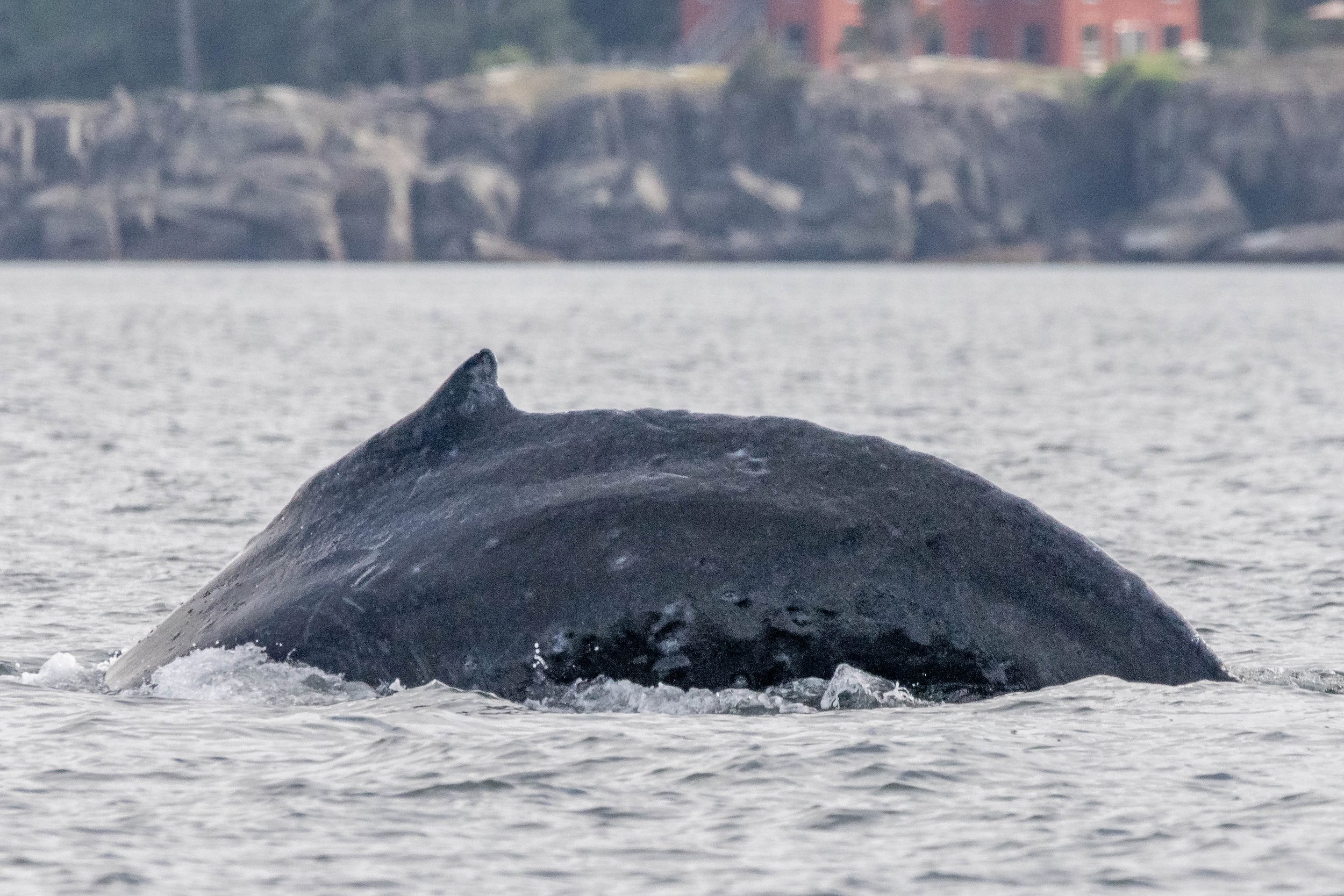June 1, 2024, 3:30 PM - The T046B1s feasting plus some travelling humpbacks
After a bustling morning trip, we were eager to get back out on the water for the afternoon trip! All three boats headed out shortly after returning to harbour. Thanks to our morning trip, we knew exactly where to find the T046B1s so headed straight to the whales!
T046B1 Tread ♀ (2003)
T046B1A Tsakani ♀ (2015)
T046B1C (2022)
We caught up with them just south of De Courcy Island and west of Ruxton Pass, right where we left them earlier in the day. Our morning guests got to witness our family of orca successfully hunting a sea lion and when we arrived we could see that the meal wasn’t finished. Our whales were still celebrating with a whole host of incredible behaviours to watch. They were surfacing quickly, passing around a chunk of meat, likely from their earlier meal.
We know that it can be a bit tough to watch these apex predators hunt, but it is important to remember that this is part of the circle of life. Everything must eat, and for predators that means eating other animals!
Once we departed our humpbacks we once again went into search mode. This time we were looking for the other common species in our area: Humpbacks! We scanned and scanned until we found what we were searching for - a group of 4 humpbacks foraging together!
We identified these whales as Spock (BCY1134), Hendrix (BCY1278), Neptune (BCY1021), and Ocular (BCX1705). We also spotted one lone humpback off in the distance that we identified as Seabird (BCX1774).
While all these whales have very unique flukes, Ocular’s was the easiest to pick out from the crowd. The base of Ocular’s fluke, along with his spine and dorsal fin, are all covered with large entanglement scars. The base of Ocular’s flukes is so scarred up it almost looks like there are ‘meatball’-like growths off either side. This was likely caused by a line wrapping around and cutting into their skin. Sadly, over 50% of our Humpback population has scars from entanglement. Entanglement is very dangerous and can be deadly if they are unable to free themselves.
Besides using our photos for identification, we always keep an eye out for signs of entanglement as well. If we ever spot a whale that is caught up in ghost gear or lines, we report them to the Marine Mammal Incident Reporting Hotline (1-800-465-4336). This specialized team can then be called out to assist in disentangling the whale if necessary, like in this case on October 14, 2022, where Slits (BCY0946) had to be helped out.
Once we were done watching our whales we continued our trip to see other wildlife. We spotted several grumbling sea lions at “Stinky Rocks”, a small rocky outcropping outside the Gulf Islands. There was also a group of Harbour seals lounging away, and there was even a River Otter swimming along too!
To wrap up the day we made one last stop at the Gabriola Bluffs. Here we saw our resident Bald Eagles feeding their chick, as well as a number of Cormorants sunning themselves and building their nests. After that, we turned back towards the Nanaimo harbour to conclude another wonderful day out on the water!
Please enjoy these photos by Marine Naturalists Aly Kohlman, Vanessa Vereschahen, and Hayleigh Hilbert!
Hendrix (BCY1278) fluking. Photo by Aly Kohlman.
Spock (BCY1134)’s top fluke. Photo by Aly Kohlman.
Spock (BCY1134) fluking.Photo by Hayleigh Hilbert.
Neptune (BCY1021) fluking. Photo by Vanessa Vereschahen.
Spock (BCY1134), Hendrix (BCY1278), and Neptune (BCY1021). Photo by Aly Kohlman.
Ocular (BCX1705) diving with his entanglement scarring visible. Photo by Aly Kohlman.
Ocular (BCX1705) fluking. Photo by Hayleigh Hilbert.
Neptune (BCY1021) fluking with Spock (BCY1134) beside them. Photo by Hayleigh Hilbert.
Hendrix (BCY1278) - they have a scar along their right top fluke’s edge - can you spot it here? Photo by Vanessa Vereschahen.
A fluke waterfall! Photo by Vanessa Vereschahen.
Swimming through the waves. Photo by Vanessa Vereschahen.
Ocular (BCX1705)’s dorsal fin. Photo by Vanessa Vereschahen.
While not a full fluke, this little corner is enough to confirm this whale’s ID. This is Seabird (BCX1774)! Photo by Hayleigh Hilbert.
T046B1 Tread. Photo by Aly Kohlman.
Flukes up! Photo by Aly Kohlman.
Each whale’s flukes are a little different! Photo by Vanessa Vereschahen.
T046B1A Tsakani. Photo by Aly Kohlman.
Full speed ahead! Photo by Aly Kohlman.
T046B1A Tsakani with her fluke out of the water. Photo by Aly Kohlman.
T046B1A Tsakani cutting through the waters. Photo by Aly Kohlman.
T046B1A Tsakani sporting some new scratches in her eyepatch. Photo by Aly Kohlman.
These three were very excited about their lunch today. Photo by Vanessa Vereschahen.
T046B1C with a gull right beside them. Photo by Vanessa Vereschahen.
T046B1 Tread and her daughter T046B1A Tsakani. Photo by Vanessa Vereschahen.
The full T046B1 family! T046B1A Tsakani, T046B1 Tread, and T046B1C. Photo by Vanessa Vereschahen.
T046B1A Tsakani backdiving with leftovers on her chest. Photo by Vanessa Vereschahen.
A River otter swimming along. Photo by Aly Kohlman.
A bob of sleepy Harbour seals. Photo by Aly Kohlman.
Blep! Photo by Aly Kohlman.
Look at those teeth! Photo by Aly Kohlman.
A Turkey Vulture scouting the shoreline. Photo by Aly Kohlman.
Photo by Aly Kohlman.
Cormorants in the sunshine. Photo by Vanessa Vereschahen.
A Bald eagle rousing at the top of a tree. Photo by Vanessa Vereschahen.
Taking off from the nest. Photo by Aly Kohlman.
Something caught this eagle’s attention below - maybe a fish? Photo by Aly Kohlman.
Staring down below. Photo by Aly Kohlman.





































